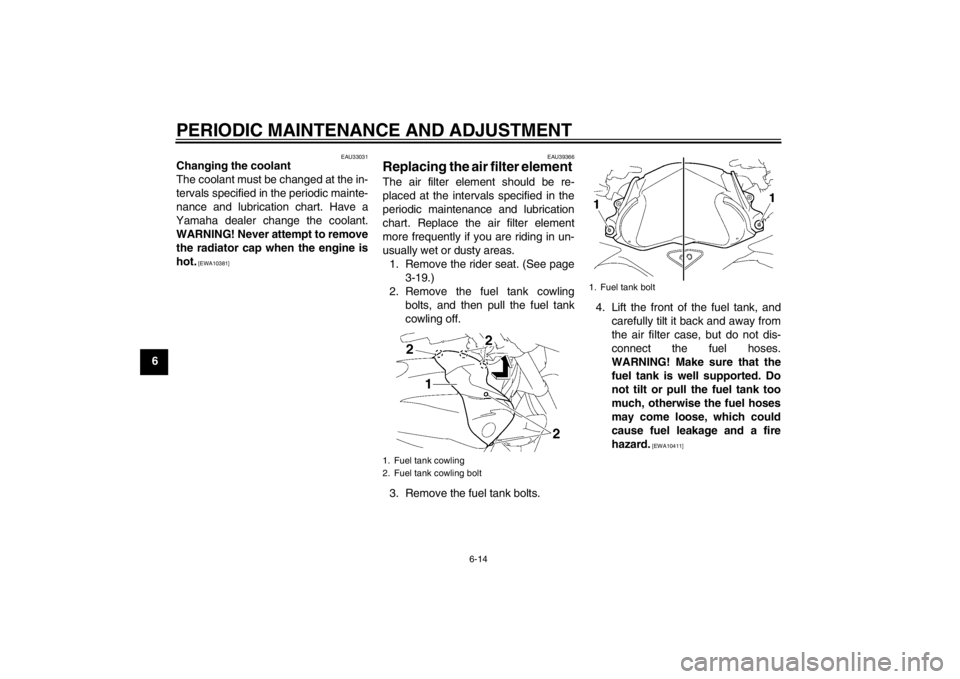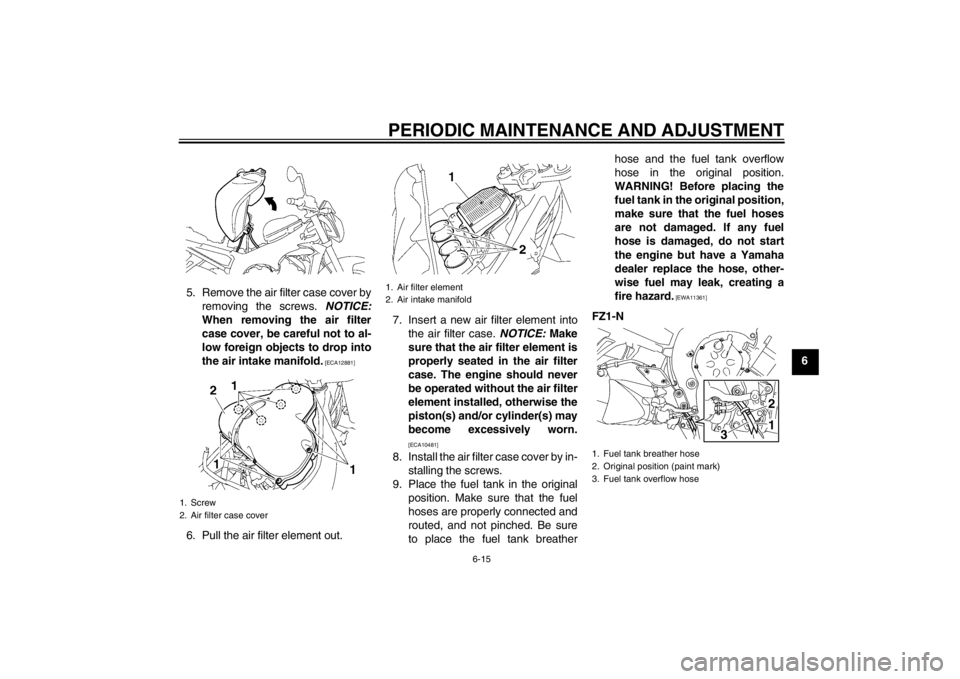Page 33 of 106

INSTRUMENT AND CONTROL FUNCTIONS
3-18
3
ately. If gasoline spills on your skin,
wash with soap and water. If gaso-
line spills on your clothing, change
your clothes.
EAU13321
NOTICE
ECA11400
Use only unleaded gasoline. The use
of leaded gasoline will cause severe
damage to internal engine parts,
such as the valves and piston rings,
as well as to the exhaust system.Your Yamaha engine has been de-
signed to use regular unleaded gaso-
line with a research octane number of
91 or higher. If knocking (or pinging) oc-
curs, use a gasoline of a different brand
or premium unleaded fuel. Use of un-
leaded fuel will extend spark plug life
and reduce maintenance costs.
EAU51170
Fuel tank breather hose and
overflow hose FZ1-N
FZ1-NA FZ1-NA
Before operating the motorcycle:
●
Check each hose connection.
●
Check each hose for cracks or
damage, and replace if damaged.
●
Make sure that the end of each
hose is not blocked, and clean if
necessary.
Recommended fuel:
Regular unleaded gasoline only
Fuel tank capacity: 18.0 L (4.76 US gal, 3.96 Imp.gal)
Fuel reserve amount: 3.4 L (0.90 US gal, 0.75 Imp.gal)
1. Fuel tank breather hose
2. Original position (paint mark)
3. Fuel tank overflow hose
1. Fuel tank overflow hose
2. Original position (paint mark)
3
2121
1. Fuel tank breather hose
2. Original position (paint mark)
1 2
U1ECE1E0.book Page 18 Monday, August 8, 2011 11:52 AM
Page 44 of 106

FOR YOUR SAFETY – PRE-OPERATION CHECKS
4-1
4
EAU15596
Inspect your vehicle each time you use it to make sure the vehicle is in safe operating condition. Always follow the inspection
and maintenance procedures and schedules described in the Owner’s Manual.
WARNING
EWA11151
Failure to inspect or maintain the vehicle properly increases the possibility of an accident or equipment damage.
Do not operate the vehicle if you find any problem. If a problem cannot be corrected by the procedures provided in
this manual, have the vehicle inspected by a Yamaha dealer.Before using this vehicle, check the following points:
ITEMCHECKS PAGE
Fuel Check fuel level in fuel tank.
Refuel if necessary.
Check fuel line for leakage.
Check fuel tank breather hose and overflow
hose for obstructions, cracks or dam-
age, and check hose connections. 3-17, 3-18
Engine oil Check oil level in engine.
If necessary, add recommended oil to specified level.
Check vehicle for oil leakage. 6-10
Coolant Check coolant level in reservoir.
If necessary, add recommended coolant to specified level.
Check cooling system for leakage. 6-13
Front brake Check operation.
If soft or spongy, have Yamaha dealer bleed hydraulic system.
Check brake pads for wear.
Replace if necessary.
Check fluid level in reservoir.
If necessary, add specified brake fluid to specified level.
Check hydraulic system for leakage. 6-22, 6-23
U1ECE1E0.book Page 1 Monday, August 8, 2011 11:52 AM
Page 49 of 106

OPERATION AND IMPORTANT RIDING POINTS
5-3
5
EAU16810
Tips for reducing fuel con-
sumption Fuel consumption depends largely on
your riding style. Consider the following
tips to reduce fuel consumption:●
Shift up swiftly, and avoid high en-
gine speeds during acceleration.
●
Do not rev the engine while shifting
down, and avoid high engine
speeds with no load on the engine.
●
Turn the engine off instead of let-
ting it idle for an extended length of
time (e.g., in traffic jams, at traffic
lights or at railroad crossings).
EAU16841
Engine break-in There is never a more important period
in the life of your engine than the period
between 0 and 1600 km (1000 mi). For
this reason, you should read the follow-
ing material carefully.
Since the engine is brand new, do not
put an excessive load on it for the first
1600 km (1000 mi). The various parts in
the engine wear and polish themselves
to the correct operating clearances.
During this period, prolonged full-throt-
tle operation or any condition that might
result in engine overheating must be
avoided.
EAU17093
0–1000 km (0–600 mi)
Avoid prolonged operation above 6000
r/min. NOTICE: After 1000 km (600
mi) of operation, the engine oil must
be changed and the oil filter car-
tridge or element replaced.
[ECA10302]
1000–1600 km (600–1000 mi)
Avoid prolonged operation above 7200
r/min. 1600 km (1000 mi) and beyond
The vehicle can now be operated nor-
mally.
NOTICE
ECA10310
●
Keep the engine speed out of
the tachometer red zone.
●
If any engine trouble should oc-
cur during the engine break-in
period, immediately have a
Yamaha dealer check the vehi- cle.
U1ECE1E0.book Page 3 Monday, August 8, 2011 11:52 AM
Page 50 of 106
OPERATION AND IMPORTANT RIDING POINTS
5-4
5
EAU17213
Parking When parking, stop the engine, and
then remove the key from the main
switch.
WARNING
EWA10311
●
Since the engine and exhaust
system can become very hot,
park in a place where pedestri-
ans or children are not likely to
touch them and be burned.
●
Do not park on a slope or on soft
ground, otherwise the vehicle
may overturn, increasing the
risk of a fuel leak and fire.
●
Do not park near grass or other
flammable materials which
might catch fire.
U1ECE1E0.book Page 4 Monday, August 8, 2011 11:52 AM
Page 53 of 106

PERIODIC MAINTENANCE AND ADJUSTMENT
6-3
6
EAU46861
TIP●
The annual checks must be performed every year, except if a kilometer-based maintenance, or for the UK, a
mileage-based maintenance, is performed instead.
●
From 50000 km (30000 mi), repeat the maintenance intervals starting from 10000 km (6000 mi).
●
Items marked with an asterisk should be performed by a Yamaha dealer as they require special tools, data and technical
skills.
EAU46910
Periodic maintenance chart for the emission control system NO. ITEM CHECK OR MAINTENANCE JOBODOMETER READING
ANNUAL
CHECK
1000 km
(600 mi) 10000 km
(6000 mi) 20000 km
(12000 mi) 30000 km
(18000 mi) 40000 km
(24000 mi)
1 *Fuel line Check fuel hoses for cracks or
damage. √√√√√
2 *Spark plugs Check condition.
Clean and regap.
√√
Replace. √√
3 *Valves Check valve clearance.
Adjust.
Every 40000 km (24000 mi)
4 *Fuel injection Adjust engine idling speed and
synchronization. √√√√√√
5 *Muffler and exhaust
pipe Check the screw clamp(s) for
looseness. √√√√√
6 *Air induction sys-
tem Check the air cut-off valve, reed
valve, and hose for damage.
Replace the entire air induction system if necessary. √√√√√
U1ECE1E0.book Page 3 Monday, August 8, 2011 11:52 AM
Page 64 of 106

PERIODIC MAINTENANCE AND ADJUSTMENT
6-14
6
EAU33031
Changing the coolant
The coolant must be changed at the in-
tervals specified in the periodic mainte-
nance and lubrication chart. Have a
Yamaha dealer change the coolant.
WARNING! Never attempt to remove the radiator cap when the engine is
hot.
[EWA10381] EAU39366
Replacing the air filter element The air filter element should be re-
placed at the intervals specified in the
periodic maintenance and lubrication
chart. Replace the air filter element
more frequently if you are riding in un-
usually wet or dusty areas.
1. Remove the rider seat. (See page 3-19.)
2. Remove the fuel tank cowling bolts, and then pull the fuel tank
cowling off.
3. Remove the fuel tank bolts. 4. Lift the front of the fuel tank, and
carefully tilt it back and away from
the air filter case, but do not dis-
connect the fuel hoses.
WARNING! Make sure that the
fuel tank is well supported. Do
not tilt or pull the fuel tank too
much, otherwise the fuel hoses
may come loose, which could
cause fuel leakage and a fire
hazard.
[EWA10411]
1. Fuel tank cowling
2. Fuel tank cowling bolt
1. Fuel tank bolt
U1ECE1E0.book Page 14 Monday, August 8, 2011 11:52 AM
Page 65 of 106

PERIODIC MAINTENANCE AND ADJUSTMENT
6-15
6
5. Remove the air filter case cover by
removing the screws. NOTICE:
When removing the air filter
case cover, be careful not to al-
low foreign objects to drop into
the air intake manifold.
[ECA12881]
6. Pull the air filter element out. 7. Insert a new air filter element into
the air filter case. NOTICE: Make
sure that the air filter element is
properly seated in the air filter
case. The engine should never
be operated without the air filter
element installed, otherwise the
piston(s) and/or cylinder(s) may
become excessively worn.
[ECA10481]
8. Install the air filter case cover by in- stalling the screws.
9. Place the fuel tank in the original position. Make sure that the fuel
hoses are properly connected and
routed, and not pinched. Be sure
to place the fuel tank breather hose and the fuel tank overflow
hose in the original position.
WARNING! Before placing the fuel tank in the original position,
make sure that the fuel hoses
are not damaged. If any fuel
hose is damaged, do not start
the engine but have a Yamaha
dealer replace the hose, other-
wise fuel may leak, creating a
fire hazard.
[EWA11361]
FZ1-N
1. Screw
2. Air filter case cover
1. Air filter element
2. Air intake manifold
1. Fuel tank breather hose
2. Original position (paint mark)
3. Fuel tank overflow hose
3
21
U1ECE1E0.book Page 15 Monday, August 8, 2011 11:52 AM
Page 66 of 106
PERIODIC MAINTENANCE AND ADJUSTMENT
6-16
6FZ1-NA
FZ1-NA
10. Install the fuel tank bolts.
11. Place the fuel tank cowling in the original position, and then install
the fuel tank cowling bolts. 12. Install the rider seat.
EAU34301
Adjusting the engine idling
speed The engine idling speed must be
checked and, if necessary, adjusted as
follows at the intervals specified in the
periodic maintenance and lubrication
chart.
The engine should be warm before
making this adjustment.
Check the engine idling speed and, if
necessary, adjust it to specification by
turning the idle adjusting screw. To in-
crease the engine idling speed, turn the
screw in direction (a). To decrease the
engine idling speed, turn the screw in
direction (b).
1. Fuel tank overflow hose
2. Original position (paint mark)
1. Fuel tank breather hose
2. Original position (paint mark)
21
1
2
1. Idle adjusting screw
U1ECE1E0.book Page 16 Monday, August 8, 2011 11:52 AM